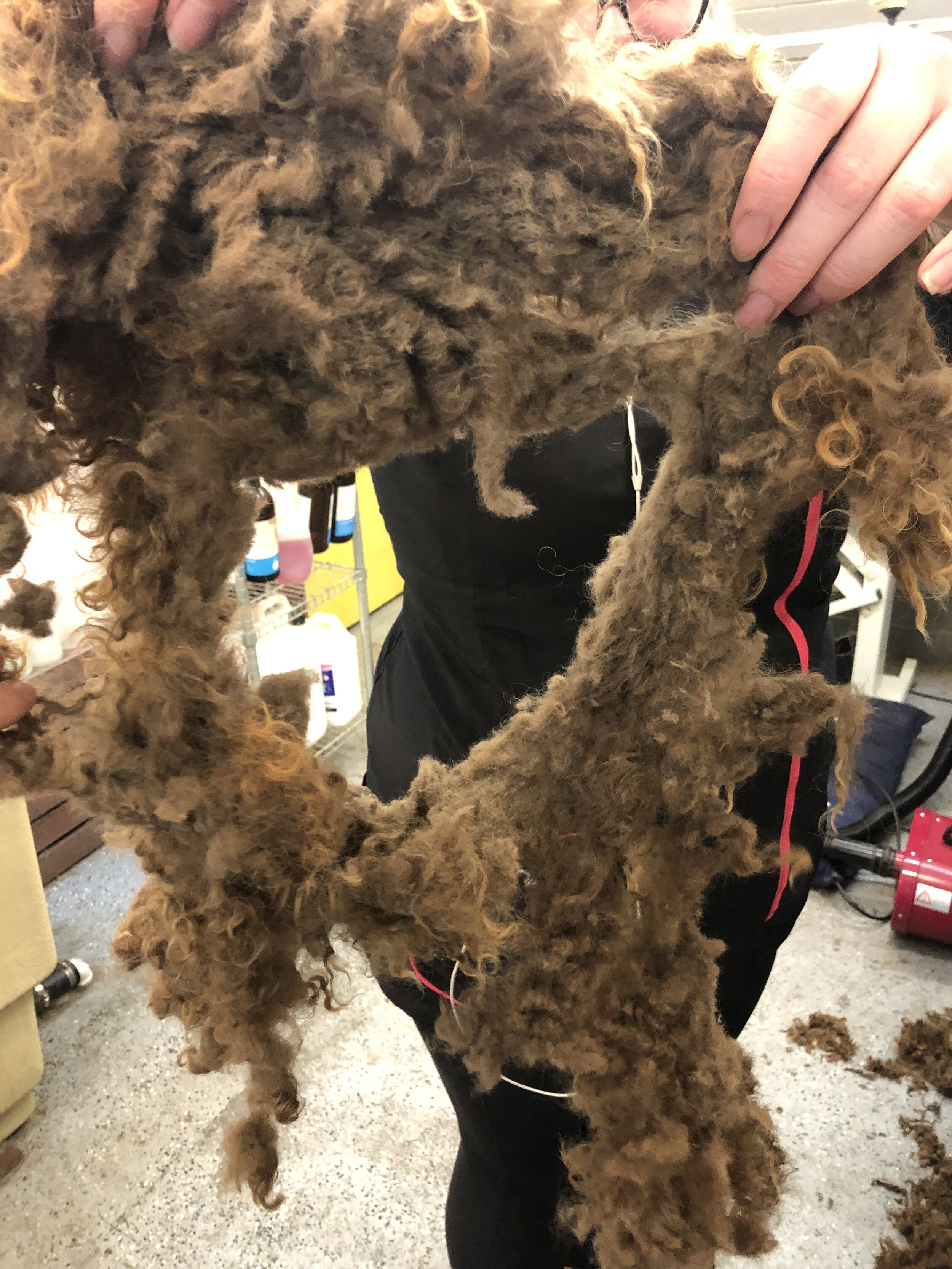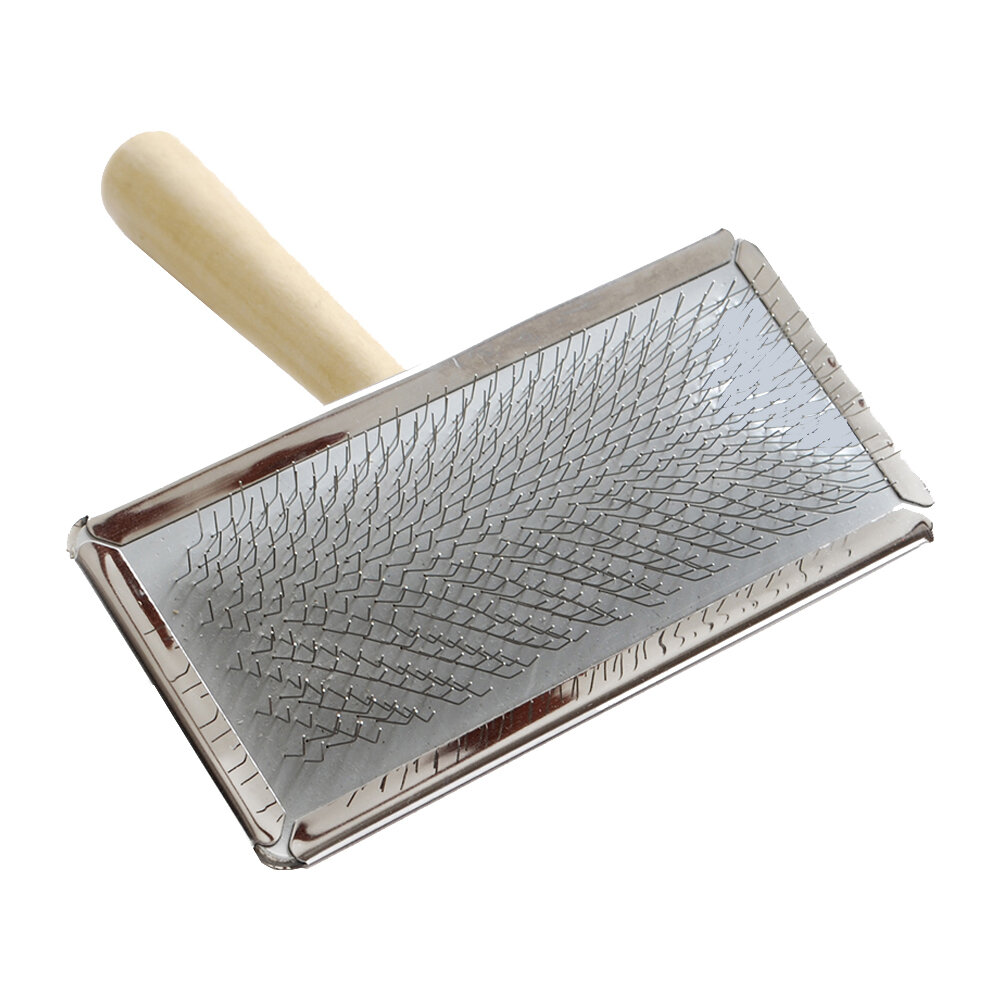Help! My dog is matted!
Cavoodles, Labradoodles and Groodles, Oh My!
The rise of the 'oodle is by no means slowing down, and while these pooches can make for fantastic family pets, and there is much to love about them, amongst groomers it is common knowledge that education about coat maintenance seems to be one of the less talked about aspects of bringing your puppy home.
Today's discussion is going to focus on matting in dogs, and in particular, focus on the ‘Ooodle coat.
With out delving too far into the science, all mammals grow hair on some part of, if not all over, their body. All hair, whether we call it that or fur or wool etc… has a life cycle in which it grows, rests and falls out. This is true of all mammals, not just dogs, but applies even to those dogs considered to be ‘low’ shedding or ‘no’ shedding dogs. It all has to do with the life cycle of their hair, and how often it dies and drops off.
The undercoat (secondary hair shaft) lies closest to the dog’s skin and has a soft, downy appearance its job is to protect against the cold weather, it does not grow longer than a few centimetres in length.
The guard hairs (primary hair shaft) are harder in texture, thicker in diameter and longer than the downy undercoat. The guard hairs protect the skin from superficial injuries, sunburn and provides insulation.
Therefore, saying that a dog does not shed, is not biologically correct. Dogs likes labradors and pugs will shed lots of hair all the time, because their hair has a very short life cycle. Other dogs, like border collies or retrievers, might shed large amounts twice a year, and only moderately the rest of the time because their guard hairs have a longer life cycle, but their undercoat (which increases in the colder months) has a short life cycle. Dogs such as poodles have very little undercoat, but their guard hair has a long life cycle, so they will shed very little, but all the time.
Can you start to see where the crossing of these different breeds can create a problematic coat?
It is also very important to note, that the guard hairs and undercoat have different life cycles, even on the same dog! Which often plays into a dog being matted, and owners not being aware! It looks fine on the surface, it feels fine to touch, the brush is going through the top when being brushed. However, underneath it’s often a different story.
Because we are only seeing the tips of the longer guard hairs, closer to the skin these hairs are entwined with the shorter undercoat, which due to the low-shedding genetics of the poodle, are not dropping as easily as they did from their labrador/retriever/cavalier ancestors, but staying put and matting tightly together.
So, what exactly is matting?
“Matting” refers to clumps of hair in your pets coat that have become densely tangled together. Without regular maintenance, loose dead hair and live hair become embedded together forming masses which creep out like a spider’s web, in sever cases, matting will essentially encase the dog and when shaved, will come off in one big pelt, like shaving a sheep!
Sometimes, when matts are caught early and haven’t become too severe, they can be combed out, but there is a fine line between ‘okay’ to comb out and ‘too severe’ which can be crossed almost in the blink of an eye, and once this line is crossed, combing is impossible without causing pain for the dog. Also, much of the process of ‘de-matting’ is actually causing the hair to break. Leading to frizzy, broken strands (similar to split ends on our own head) which are prone to matting more easily.
Matting will often occur in areas of friction, such as around the collar, harness or jacket, behind the ears and on the ears themselves, around the tail, in the armpits and on the legs. Lack of grooming, especially in these areas, will cause these tangles to get worse over time.
Because de-matting is very painful for the dog, most groomers will have a “Humanity before Vanity” mentality about your dogs knots, and will recommend clipping the coat back to below the matting point. This may not look the cutest, but its going to make your dog feel 1000 times better, almost instantly.
Sometimes it might take a few days for them to get used to the new haircut feeling (I know I can’t stop touching my now do after a big chop!) as they adjust to the lost weight of the dead hair and their blood flows freely again. Severe matting cannot sometime cause bruising on the skin where restricted blood flow is suddenly returned.
This adjustment might cause freshly slipped dogs to scratch more, drag or roll across the floor, or shake their head a bit. This is quite normal, and nothing to worry about. Always monitor your dog if they are exhibiting such behaviours and seek advice from your groomer or vet should this carry on for longer than a few days.
Removal of matted coats is not an easy job, and will often require a longer than a standard grooming appointment, as it is a delicate process, requiring an experienced hand. Dogs have incredibly thin skin, and when matting is close to the skin (especially in delicate areas such as the legs, groin and ears) there is a higher risk of accidents occurring. Even when done properly and safely, the risk of nicks and cuts is higher due to the nature of the job.
Removing a matted coat with clippers
A matted pelt after removal from a dogs body.
The Dangers of Matted Coats.
Matting is not only uncomfortable for your dog, but it can also hide an array of health complications that we are unable to detect when hidden beneath a thick layer of hair. As groomers we have often uncovered skin irritations, fleas and other bugs, allergic flare ups, hot spots… as well as foreign objects (sticks, grass seeds and garden matter are not uncommon, but we’ve also found bandaids, small plastic toys, and even a fishing hook!) One really dangerous aspect of things getting trapped in the coat, is that with the pressure, debris can actually become embedded in the skin.
Matted coats will deny proper air flow too, meaning that the skin can become unhealthy, develop fungus or dandruff or emit undesirable smells. Matted coats will also play host to excess dirt including urine, poop, mud, mould, all of which will further irritate the skin (and how many of us let our dogs sleep in our beds with us?)
In very extreme cases (usually in situations of neglect) matting has been known to cut off blood flow to the extremities, leading to the loss of limbs or ears in some cases.
How to stay on top of the matting.
Prevention is key, regular brushing & combing (from the root to the tip) is vital. Make sure to focus on the friction points addressed above, and use the correct tools. A slicker brush and a metal toothed comb are the best tools to have on hand.
Slicker brush
Helpful to break up small knots and overall brushing. Does not generally reach the roots on longer or thicker haired dogs.
Metal Comb
For Brushing from root to tip, helpful to remove small knots and tangles.
2. If your dog goes swimming or you bath them at home, make sure they are completely brushed and combed PRIOR to getting wet, and properly dried afterwards (make sure to follow up with another brush out). Ideally, combination ‘Oodle coats should be fully dried with a hair drier, as allowing them to dry naturally can expedite matting.
3. Be careful about the use of harnesses and coats. The friction caused by these accessories often makes matting worse. Don’t leave coats and harnesses on for long periods of time, and always brush your dog after removing these accessories. Make sure you alwasy remove their collar and brush out this area too.
4. Opt for a shorter or manageable style. You may love the look of a longer clip, but the maintenance at home, may be difficult with your lifestyle. a medium or shorter fluffy style might suit you better, and is one of our most popular clips.
5. Book your dog in for regular grooming appointments to prevent a matted coat and for healthy skin and coat care. Our general recommendation is somewhere in the vicinity of every 4 - 8 weeks. If you want a longer style, you’ll need to see your groomer closer to the 4 week range. We are always happy to, and always recommend that you pre-book your appointments, or even set up a recurring schedule. Our loyalty program rewards you with an immediate discount on all appointments that occur within 8 weeks of each other.
Your Groomer’s 2 Cents
Remember, seeing the groomer doesn’t always mean having a hair cut, a tidy up service between each clip will make a massive difference in your dogs appearance as well as the health of their skin and coat.
And please remember, groomers HATE shaving dogs. It deprives us of any chance of demonstrating our creativity, or the skills we’ve worked hard to acquire through many years of training and experience.
We do not get any joy out of clipping a matted coat, and often we find it incredibly upsetting. We want to work with our clients to get the best out of each groom, so please keep that in mind if you’re ever faced with a groomer's advice to shave your matted dog. We are doing so in your dogs best interest. We know how much you love your dog, and the reality of matting can be a shock to many wonderful pet owners.
Groomers love dogs, this is not an industry for making millions, its not a glamorous job. We spend every day getting wet, dirty, scratched and picking up poop. We do this, because we love it, we love styling the coat of a beautifully maintained pooch and making them look and feel amazing. We love seeing the joy on your face when you come to pick them up, and we would love to help you to learn how to keep your dogs coat in it’s best condition, and therefore, looking gorgeous all year round, and our advice is always meant in sincerity and the best well being of your dog.
If you would like to know more about matting, the science of hair growth or how to best keep your pooch in tip top shape, the team at Wagtime Co. are always happy to lend a hand.









